ASCP Success! Urinalysis and Body Fluids
1/66
There's no tags or description
Looks like no tags are added yet.
Name | Mastery | Learn | Test | Matching | Spaced |
|---|
No study sessions yet.
67 Terms
Why is the first-voided morning urine specimen the most desirable specimen for routine urinalysis?
A. Most dilute specimen of the day and therefore any chemical compounds present will not exceed the detectability limits of the reagent strips
B. Least likely to be contaminated with microorganisms because the bladder is a sterile environment
C. Most likely to contain protein because the patient has been in the orthostatic position during the night
D. Most concentrated specimen of the day and therefore it is more likely that abnormalities will be detected
D. Most concentrated specimen of the day and therefore it is more likely that abnormalities will be detected
The first-voided morning urine specimen is the most desirable for chemical and microscopic analysis because it is the most concentrated specimen of the day. Protein and nitrite testing is better performed on a concentrated specimen, as are the specific gravity determination and the examination of urinary sediment. However, because of the lack of food and fluid intake during the night, glucose metabolism may be better assessed on the basis of a postprandial specimen.
The physical characteristic of color is assessed when a routine urinalysis is performed. What substance is normally found in urine that is principally responsible for its yellow coloration?
A. Bilirubin
B. Melanin
C. Carotene
D. Urochrome
D. Urochrome
a yellow-brown pigment derived from urobilin, is principally responsible for the yellow coloration of normal urine. Urochrome is excreted at a constant rate, showing no diurnal variation. Therefore, the color of normal urine, which may range from straw to deep amber, is dependent on the concentrating ability of the kidney and the volume of urine excreted.
In certain malignant disorders, what substance is found in the urine that turns the urine dark brown or black on exposure of the urine to air?
A. Urobilinogen
B. Indican
C. Melanin
D. Porphyrin
C. Melanin
In cases of metastatic melanoma, melanogen, which is a colorless precursor of melanin, is excreted in the urine. If the urine is allowed to stand at room temperature for 24 hours, the melanogen is oxidized to melanin, imparting a dark brown or black coloration to the specimen. Qualitative screening tests for the detection of melanin in urine use ferric chloride or sodium nitroprusside as the oxidation reagent systems.
What is the expected pH range of a freshly voided urine specimen?
A. 3.5-8.0
B. 3.5-9.0
C. 4.0-8.5
D. 4.5-8.0
D. 4.5-8.0
pH is a representative symbol for the hydrogen ion concentration. The kidney plays an important role in the maintenance of the acidbase balance of body fluids by either excreting or retaining hydrogen ions. A normally functioning kidney will excrete urine with a pH between 4.5 and 8.0, depending on the overall acid-base needs of the body.
Urine specimens should be analyzed as soon as possible after collection. If urine specimens are allowed to stand at room temperature for an excessive amount of time, the urine pH will become alkaline
because of bacterial decomposition of:
A. Protein
B. Urea
C. Creatinine
D. Ketones
B. Urea
At room temperature, the amount of bacteria present in a urine sample will increase. The bacteria are capable of metabolizing the urinary urea to ammonia. The ammonia formed through this process will cause an alkalinization of the urine.
Which term is defined as a urine volume in excess of 2000 mL excreted over a 24-hour period?
A. Anuria
B. Oliguria
C. Polyuria
D. Hypersthenuria
C. Polyuria
On the average, a normal adult excretes 1200-1500 mL of urine daily. "Polyuria" is a term used to describe the excretion of a urine volume in excess of 2000 mL/day. In oliguria, the daily urine excretion is less than 500 mL, and in anuria the urine formation is completely suppressed. Hypersthenuria refers to urines of any volume containing increased levels of dissolved solute.
The reagent test strips used for the detection of protein in urine are most reactive to
A. Albumin
B. Hemoglobin
C. Alpha-globulins
D. Beta-globulins
A. Albumin
In healthy individuals the amount of protein excreted in the urine should not exceed 150 mg/24 hr. When protein is present in the urine, the colorimetric reagent test strips change color, indicating a semi-quantification of the amount of protein present. Serum proteins are classified as being albumin or globulin in nature, and the type of protein excreted in the urine is dependent on the disorder present. Although the strip test is a rapid screening method for the detection of urinary protein, it must be noted that this method is more sensitive to the presence of albumin in the specimen than to the presence of globulin, Bence Jones protein, or mucoprotein.
A urine specimen that exhibits yellow foam on being shaken should be suspected of having an increased concentration of
A. Protein
B. Hemoglobin
C. Bilirubin
D. Nitrite
C. Bilirubin
Normal urine does not foam on being shaken. However, urine containing bilirubin will exhibit yellow foaming when the specimen is shaken. In fact, the foam test was actually the first test for bilirubin, before the development of the chemical tests. If the shaken specimen shows a white foam, increased urine protein can be suspected.
How should controls be run to ensure the precision and accuracy of the reagent test strips used for the chemical analysis of urine?
A. Positive controls should be run on a
daily basis and negative controls when
opening a new bottle of test strips.
B. Positive and negative controls should
be run when the test strips' expiration
date is passed.
C. Positive and negative controls should
be run on a daily basis.
D. Positive controls should be run on a
daily basis and negative controls on a
weekly basis.
C. Positive and negative controls should
be run on a daily basis.
For quality control of reagent test strips, it is recommended that both positive and negative controls be used daily. It is necessary that any deterioration of the strips be detected in order to avoid false-positive or false-negative results. The use of positive and negative controls will act as a check on the reagents, on the technique employed, and on the interpretive ability of the person or instrument performing the test.
The colorimetric reagent strip test for protein is able to detect as little as 5-20 mg of protein per deciliter. What may cause a false-positive urine protein reading?
A. Uric acid concentration is greater than
0.5 g/day.
B. Vitamin C concentration is greater
than 0.5 g/day.
C. Glucose concentration is greater than
130mg/day.
D. pH is greater than 8.0.
D. pH is greater than 8.0.
The principle of the reagent strip method for the detection of protein in urine is based on a color change in an indicator system, such as tetrabromophenol blue, that is buffered to pH 3. The buffering capacity of the strip is sufficient provided that the urine pH does not exceed 8.0. Within the normal urine pH range of 4.5-8.0, a change in color in the reagent strip is an indication of the presence of protein in the urine. With a urine pH greater than 8, the buffering capacity of the strip may be exceeded, and a false-positive color change in the impregnated area will reflect the pH of the urine rather than the presence of protein. The presence of vitamin C, uric
acid, or glucose in urine will not affect the test for protein.
"Isosthenuria" is a term applied to a series of urine specimens from the same patient that exhibit a:
A. Specific gravity of exactly 1.000
B. Specific gravity less than 1.007
C. Specific gravity greater than 1.020
D. Fixed specific gravity of approximately
1.010
D. Fixed specific gravity of approximately
1.010
"Isosthenuria" is a term applied to a series of urine specimens that exhibit a fixed specific gravity of approximately 1.010. In isosthenuria there is little, if any, variation of the specific gravity between urine specimens from the same patient. This condition is abnormal and denotes the presence of severe renal damage in which both the diluting ability and the concentrating ability of the kidneys have been severely affected.
A urine specimen is tested by a reagent strip test and the sulfosalicylic acid test to determine whether protein is present. The former yields a negative protein, whereas the latter results in a reading of 2+ protein. Which of the following statements best explains this difference?
A. The urine contained an excessive
amount of amorphous urates or
phosphates that caused the turbidity
seen with the sulfosalicylic acid test.
B. The urine pH was greater than 8,
exceeding the buffering capacity
of the reagent strip, thus causing
a false-negative reaction.
C. A protein other than albumin must be
present in the urine.
D. The reading time of the reagent strip
test was exceeded (the reading being
taken at 2 minutes), causing a falsenegative
reaction to be detected.
C. A protein other than albumin must be
present in the urine.
When globulin, mucoprotein, or Bence Jones protein is present in a urine specimen, the reagent strip test may give a negative result because the strip is more sensitive to the presence of albumin than to the presence of other proteins in urine. However, the sulfosalicylic acid (SSA) test is able to detect not only albumin but also globulin, mucoprotein, and Bence Jones protein in a specimen. Therefore, it can be seen that a negative reagent strip test result for protein but a positive SSA test result is possible when the protein present is some protein other than albumin. For this reason the SSA test is run as a test for urinary protein if the presence of abnormal proteins is suspected.
Which of the following is the major organic substance found in urine?
A. Sodium
B. Potassium
C. Glucose
D. Urea
D. Urea
Although sodium is the major inorganic molecule found in urine, urea is the major organic molecule excreted. Urea is a waste product of protein/amino acid metabolism. Its level in a normal 24-hour urine with a glomerular filtration rate of 125 mL/min would be 400 mmol/day. Glucose excretion will average less than 1 mmol/day. The excretion of the inorganic molecules sodium and potassium would be 130 and 70 mmol/day, respectively.
Each of the following is included in the quality assurance program for a urinalysis laboratory. Which one represents a preanalytical component of testing?
A. Setting collection guidelines for
24-hour urines
B. Setting a maintenance schedule for
microscopes
C. Reporting units to be used for crystals
D. Requiring acceptable results for
control specimens before any patient
results are reported out
A. Setting collection guidelines for
24-hour urines
Preanalytical components of laboratory testing include all variables that can affect the
integrity or acceptability of the patient specimen prior to analysis, such as correct collection technique. Analytical factors affect the actual analysis of the specimen (temperature, condition of equipment, timing, presence of interfering substances). Postanalytical factors affect the final handling of the results generated (reporting units, critical values, acceptability of quality control).
The presence of ketone bodies in urine specimens may be detected by use of a reagent strip impregnated with sodium nitroprusside. This strip test is sensitive to the presence of
A. Acetoacetic acid and betahydroxybutyric
acid
B. Acetoacetic acid and acetone
C. Diacetic acid and beta-hydroxybutyric
acid
D. Beta-hydroxybutyric acid and acetone
B. Acetoacetic acid and acetone
The term "ketone bodies" is used collectively to denote the presence of acetoacetic acid, beta-hydroxybutyric acid, and acetone. Reagent test strips impregnated with sodium nitroprusside are able to detect the presence of acetoacetic acid and acetone in urine specimens. Although beta-hydroxybutyric acid accounts for approximately 78% of the total ketones, it is not detected by the sodium nitroprusside test.
A routine urinalysis is performed on a young child suffering from diarrhea. The reagent test strip is negative for glucose but positive for ketones. These results may be explained by which of the following statements?
A. The child has Type 1 diabetes mellitus.
B. The child is suffering from lactic
acidosis, and the lactic acid has falsely
reacted with the impregnated reagent
area for ketones.
C. The child is suffering from increased
catabolism of fat because of decreased
intestinal absorption.
D. The reagent area for ketones was read
after the maximum reading time
allowed.
C. The child is suffering from increased
catabolism of fat because of decreased
intestinal absorption.
Although a positive result on a urine test for ketones is most commonly associated with increased urinary glucose levels, as in diabetes mellitus, other conditions may cause the urine ketone test to show positive results while the urine glucose test shows negative results. In young children, a negative glucose reaction accompanied by a positive ketone reaction is sometimes seen. Ketones in the urine may be seen when a child is suffering from an acute febrile disease or toxic condition that is accompanied by vomiting or diarrhea. In these cases, because of either decreased food intake or decreased intestinal absorption, fat catabolism is increased to such an extent that the intermediary products, known as ketone bodies, are formed and excreted in the urine.
The principle of the colorimetric reagent strip test for hemoglobin is based on the peroxidase activity of hemoglobin in catalyzing the oxidation of a dye with peroxide to form a colored compound. This method may yield false-positive
results for the presence of hemoglobin when the urine specimen contains
A. Ascorbic acid
B. Tetracycline
C. Myoglobin
D. Nitrite
C. Myoglobin
The colorimetric reagent strip test for the detection of hemoglobin in urine utilizes a buffered test zone impregnated with a dye and organic peroxide. The peroxidase activity of hemoglobin catalyzes the oxidation of the dye with peroxide to form a colored compound. Like hemoglobin, myoglobin also has a peroxidase activity and, when present in a urine specimen, myoglobin will react, yielding false-positive results. In the presence of large amounts of ascorbic acid, antibiotics containing ascorbic acid as a preservative, formaldehyde, or nitrite, the urine reaction may be inhibited, causing false-negative results.
A reagent test strip impregnated with a diazonium salt such as diazotized 2,4-dichloroaniline may be used to determine which analyte?
A. Glucose
B. Ketone
C. Hemoglobin
D. Bilirubin
D. Bilirubin
The presence of conjugated bilirubin in a urine specimen may be detected by use of the reagent test strips. The test strips are impregnated with a diazonium salt, such as diazotized 2,4-dichloroaniline, which forms a purplish azobilirubin compound with bilirubin.
Which of the following will contribute to a specimen's specific gravity if it is present in a person's urine?
A. 50-100 RBC/hpf
B. 85 mg/dL glucose
C. 3+ amorphous phosphates
D. Moderate bacteria
B. 85 mg/dL glucose
Only dissolved solutes affect specific gravity (e.g., glucose). Cells, mucus, crystals, or any other formed elements will have no effect, regardless of concentration. If the reagent strip method is used, it should be noted that only dissolved ions will contribute to specific gravity results. Thus glucose would not affect reagent strip results at any concentration. In such instances as diabetes mellitus, with urine glucose levels over 2 g/dL, there may be a discrepancy between specific gravity results obtained with a reagent strip method versus using a refractometer, because such glucose
levels are known to increase refractometer results, thus requiring correction.
With infections of the urinary system, white blood cells are frequently seen in the urine sediment. What type of white blood cell is seen the most frequently in urine sediment?
A. Eosinophil
B. Lymphocyte
C. Monocyte
D. Neutrophil
D. Neutrophil
The majority of renal and urinary tract diseases are characterized by an increased number of neutrophilic leukocytes in the urine. To identify correctly any white blood cells present in a urine specimen, it is necessary to examine the specimen as soon as possible after collection. This is necessary because leukocytes tend to lyse easily when exposed to either hypotonic or alkaline urine.
A random urine is collected from a patient and the results obtained are as follows:
urine albumin =16 mg/dL and urine
creatinine = 140 mg/dL. These findings
are consistent with
A. Microalbuminuria
B. Macroalbuminuria
C. Nephrotic syndrome
D. Obstructive jaundice
A. Microalbuminuria
The ratio of urine albumin to creatinine in a random specimen is commonly used to evaluate microalbuminuria, especially in patients with diabetes mellitus. This patient's ratio is 114 mg albumin per gram creatinine. The American Diabetes Association defines microalbuminuria as between 30 and 299 mg/g. Values greater than 299 mg/g would be "macroalbuminuria." Nephrotic syndrome is characterized by excretion of albumin in excess of 3.5 grams per day. Patients with obstructive jaundice will usually not experience proteinuria.
To detect more easily the presence of casts in urine sediments, which microscopic method can be used?
A. Fluorescent microscopy
B. Phase-contrast microscopy
C. Polarized microscopy
D. Brightfield microscopy
B. Phase-contrast microscopy
Formed elements in the urine, such as cells and casts, are more easily differentiated by the use of phase-contrast microscopy. This is especially true for the identification of the more translucent elements such as the hyaline casts. Phase microscopy tends to enhance the outline of the formed elements, allowing them to stand out and be more easily distinguished.
Which substance found in urinary sediment is more easily distinguished by use of polarized microscopy?
A. Lipids
B. Casts
C. Red blood cells
D. Ketone bodies
A. Lipids
Fatty materials in urinary sediment may be identified by means of staining techniques using Sudan III and oil red O or by means of polarized microscopy. Polarized microscopy is especially useful when the composition of fatty casts, fatty droplets, or oval fat bodies is primarily cholesterol. When cholesterol molecules are exposed to polarized microscopy, the effect is such that a Maltese cross formation becomes visible, simplifying
the identification process.
"Glitter cell" is a term used to describe a specific type of
A. Ketone body
B. Oval fat body
C. Fatty droplet
D. Neutrophil
D. Neutrophil
When neutrophils are exposed to hypotonic urine, their physical appearance becomes altered. Under hypotonic conditions, the neutrophils tend to swell and the cytoplasmic granules contained within the cells exhibit Brownian movement. This Brownian movement of the granules causes the neutrophilic contents to refract in such a way that the cells appear to glitter—thus the name "glitter cells."
The final phase of degeneration that granular casts undergo is represented by which of the following casts?
A. Fine
B. Coarse
C. Cellular
D. Waxy
D. Waxy
Waxy casts represent the final phase of granular cast degeneration. As the fine granules of the granular casts lyse, highly refractive, smooth, blunt-ended waxy casts are formed. When waxy casts are found in the urine sediment, the implication is that there is nephron obstruction caused by tubular inflammation and degeneration.
A 40-year-old female patient with a history
of kidney infection is seen by her physician because she has felt lethargic for a few weeks. She has decreased frequency of urination and a bloated feeling. Physical examination shows periorbital swelling and general edema, including a swollen abdomen.
Significant urinalysis results
show the following: color = yellow;
appearance = cloudy/frothy; specific
gravity = 1.022;pH = 7.0; protein =
4+; 0-3 WBC/hpf; 0-1 RBC/hpf; 0-2
renal epithelial cells/hpf; 10-20 hyaline
casts/lpf; 0-1 granular casts/lpf; 0-1 fatty
casts/lpf; occasional oval fat bodies.
Her serum chemistries show significantly
decreased albumin, increased urea nitrogen, and increased creatinine. These findings suggest which condition?
A. Multiple myeloma
B. Glomerulonephritis
C. Nephrotic syndrome
D. Chronic renal failure
C. Nephrotic syndrome
Nephrotic syndrome is suggested by the
increased urine protein (with serum albumin significantly decreased), the hyaline and fatty casts, and the presence of oval fat bodies. The patient's symptoms of periorbital swelling and edema reflect the loss of oncotic pressure because of the excretion of albumin. Its loss from the vascular compartment will induce plasma water movement into the tissue spaces.
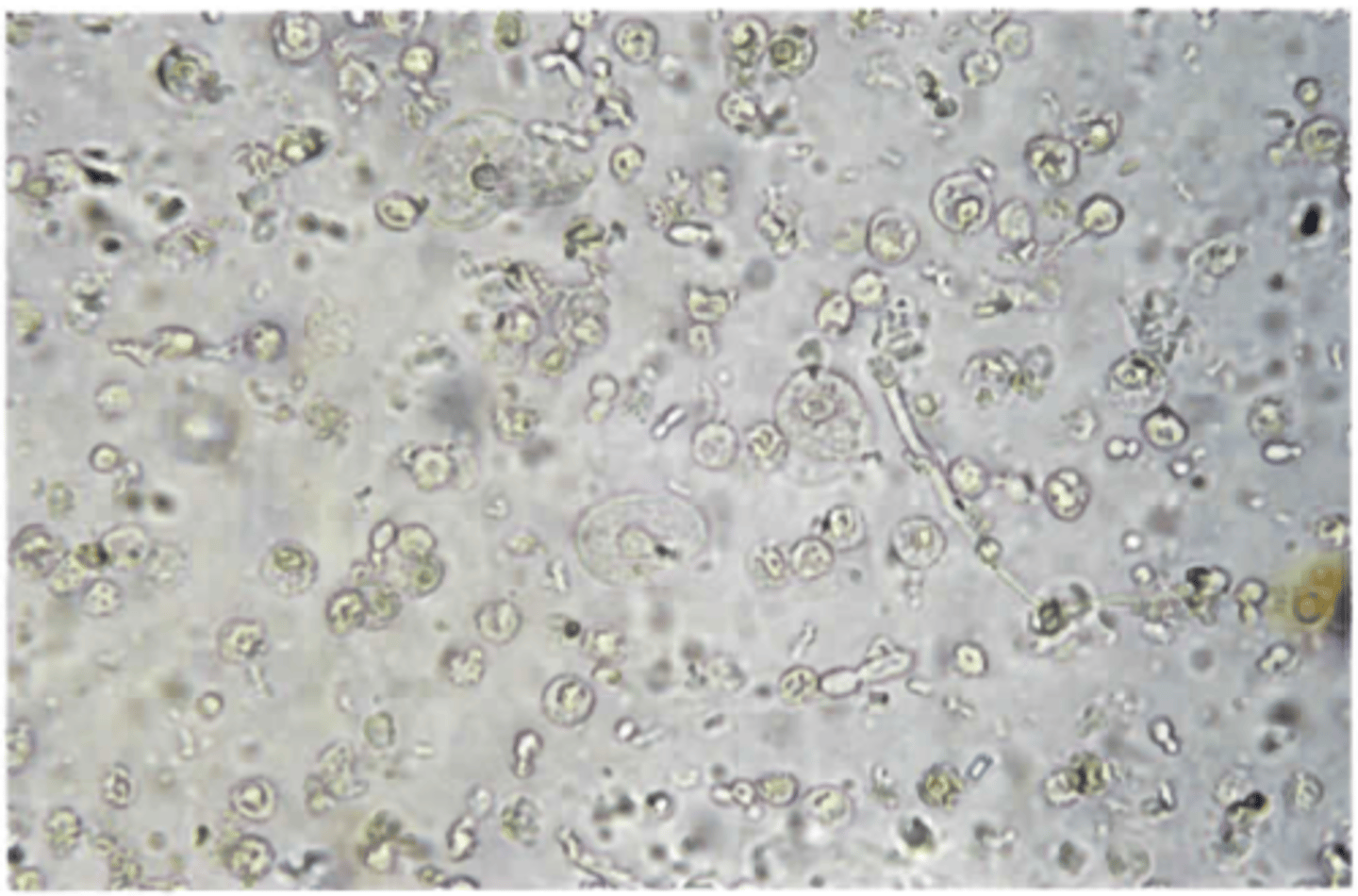
A 47-year-old female patient with controlled type 2 diabetes mellitus
complains of urinary frequency and burning. She provides a first-morning,
clean-catch specimen. Results show color = yellow; appearance = cloudy;
pH = 6.5; a representative microscopic high-power field is shown in Color
Plate 46. Which of the following is true for this patient?
A. The number of bacteria seen would result in a positive nitrite.
B. The major formed elements are white blood cells and yeast.
C. The type and number of epithelial cells suggest incorrect sample
collection.
D. The red blood cells would be sufficient to give a positive blood result on the
reagent strip.
B. The major formed elements are white
blood cells and yeast.
There are minimal bacteria present in Color Plate 46. Both budding yeast and white blood cells predominate this microscopic field. Patients with diabetes mellitus are prone to such yeast infections because of the increased glucose in their urine. The epithelial cells visualized in this field are transitional and not squamous. They can be distinguished by their size (about 15-20 um), less cytoplasm than a squamous cell would have, and their central nucleus. Increased squamous epithelial cells would suggest improper
collection, whereas transitional cells, if greater than 5 cells/hpf, would indicate pathology. There are fewer than 5 red blood cells in this field, and that would be below the sensitivity of the blood pad on the reagent strip.
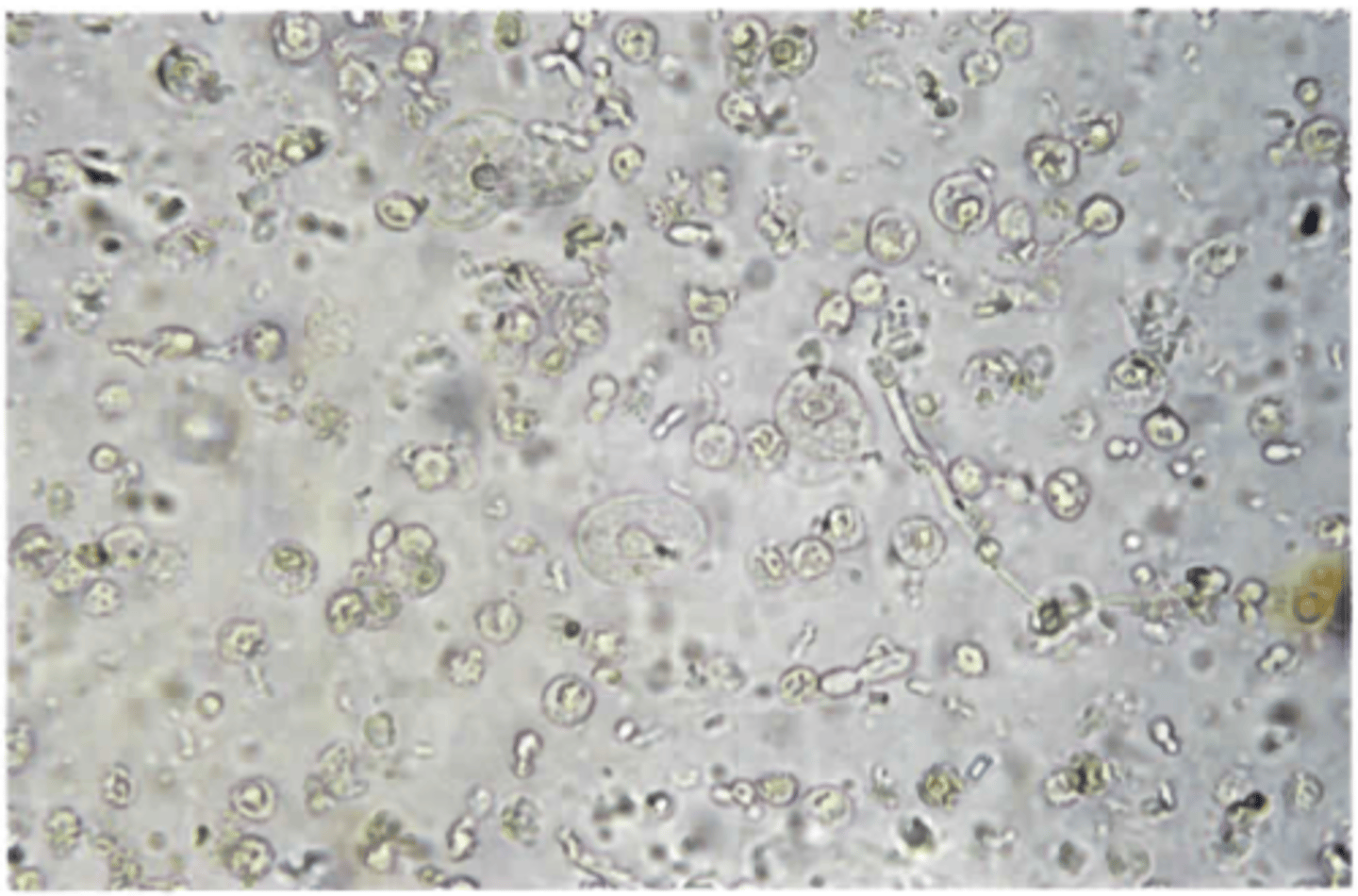
Alkaptonuria, a rare hereditary disease, is
characterized by the urinary excretion of
A. Alkaptone
B. Phenylalanine
C. 5-Hydroxyindole acetic acid
D. Homogentisic acid
D. Homogentisic acid
Alkaptonuria is a rare hereditary disease that is characterized by excessive urinary excretion of homogentisic acid. This acid accumulates in urine because of a deficiency in the enzyme homogentisic acid oxidase, which normally catalyzes the oxidation of homogentisic acid. Urine containing homogentisic acid turns black on standing because of an oxidative process; thus the screening test for alkaptonuria consists of the detection of a black coloration in urine that is left standing at room temperature for 24 hours.
A 22-year-old female clinical laboratory student performs a urinalysis on her own urine as part of a lab class.
Significant
results include: color = yellow;
appearance = cloudy; pH = 7.5;
nitrite = positive; leukocyte
esterase - 2+; 25^0 WBC/hpf;
0-3 RBC/hpf; 2-5 squamous epithelial
cells/hpf; moderate bacteria.
All other chemistries and microscopic results
were normal. These findings suggest
A. Glomerulonephritis
B. Upper urinary tract infection
C. Lower urinary tract infection
D. Nephrolithiasis
C. Lower urinary tract infection
This student has a lower urinary tract infection
(UTI), also known as cystitis. The major distinguishing features between upper and lower UTI include the presence of protein and casts in an upper UTI and not in a lower UTI. This is because both urine protein excretion and cast formation reflect what is happening within the kidney itself. The most common source of either upper or lower UTIs is contamination by enteric gram-negative bacteria.
Metastatic carcinoid tumors arising from the enterochromaffin cells of the gastrointestinal tract are characterized by increased excretion of urinary
A. Serotonin
B. 5-Hydroxytryptophan
C. Homogentisic acid
D. 5-Hydroxyindole acetic acid
D. 5-Hydroxyindole acetic acid
The intestinal enterochromaffin cells produce a substance known as serotonin from the amino acid tryptophan. In cases of metastatic carcinoid tumors, excessive amounts of serotonin are produced. Serotonin may then undergo oxidative deamination to form the metabolite 5 hydroxyindole acetic acid (5-HIAA), which is excreted in the urine. It is the quantification of 5-HIAA that is diagnostically significant because it reflects serotonin production.
Some clinical conditions are characterized by unique urinalysis result patterns. Which of the following shows such a relationship?
A. Nephrotic syndrome: positive protein
on reagent strip, negative protein with
sulfosalicylic acid
B. Intensive dieting: increased ketones,
negative glucose
C. Multiple myeloma: positive protein
by both reagent strip and sulfosalicylic
acid
D. Cystitis: positive nitrite and protein
B. Intensive dieting: increased ketones,
negative glucose
Because of increased lipid metabolism in long-term, intensive dieting, ketone body formation will increase. Blood glucose levels in such patients will be normal or decreased. In nephrotic syndrome, the large amounts of albumin excreted will be detectable by both reagent strip and SSA methods. In multiple myeloma, however, the increased globulin light chains (Bence Jones proteins) excreted will only be detectable by SSA because the reagent strip is more sensitive to albumin.
Cystitis is a lower urinary tract infection affecting the bladder but not the kidney itself.
This infection will not exhibit increased protein, whereas an upper urinary tract infection will.
Nitrite in a urine specimen suggests the presence of
A. White blood cells
B. Red blood cells
C. Bacteria
D. Yeasts
C. Bacteria
Bacteria of the Enterobacter, Citrobacter, Escherichia, Proteus, Klebsiella, and Pseudomonas species produce enzymes that catalyze the reduction of nitrate, a substance normally found in urine, to nitrite. Reagent test strips have been developed that are able to detect nitrite in urine. Therefore, a positive nitrite test result is an indirect indication of the presence of bacteria in the urine specimen.
If a fasting plasma glucose level of 100 mg/dL is obtained on an individual, what is the expected fasting cerebrospinal fluid (CSF) glucose level in mg/dL?
A. 25
B. 50
C. 65
D. 100
C. 65
Cerebrospinal fluid (CSF) is a clear, colorless liquid that may be described as a modified ultrafiltrate of blood. Both active transport and passive diffusion are involved in the passage of glucose from the blood into the CSF. Normally, fasting CSF glucose levels range between 50 and 80 mg/dL, representing approximately 60-70% of the blood glucose level. In hyperglycemia with plasma glucose levels of 300 mg/dL, the active transport mechanism reaches a point of maximum response, so that CSF glucose levels reflect approximately 30% of the plasma glucose level. Decreased CSF glucose levels are associated with hypoglycemia, a faulty active transport mechanism, and excess utilization of glucose by microorganisms, red or white blood cells, or the central nervous system.
A 35-year-old man has just experienced severe crush injuries sustained in a car accident. He has a broken pelvis and right femur and has numerous abrasions and contusions. A random urinalysis specimen shows a brown color and clear appearance. pH is 6.0, protein is 1 + , and blood is 3+. There is, however, only 0-1 RBC/hpf, along with 0-3 WBC/hpf. Casts found include hyaline (0-2/lpf) and granular (0-1/Ipf). Other urine results are normal. Which of the following is true about this patient?
A. The positive blood result is from a
hemolytic anemia.
B. The bilirubin result should have also
been positive for this patient.
C. Rhabdomyolysis may be a cause for
the discrepant chemical/microscopic
blood findings.
D. The bone crushing led to the increased
protein result.
C. Rhabdomyolysis may be a cause for
the discrepant chemical/microscopic
blood findings.
In addition to hemoglobin, the muscle protein myoglobin can cause a positive blood result in chemical reagent strip testing. Both hemoglobin and myoglobin possess pseudoperoxidase activity detected by the "blood" chemistry test. Muscle-crushing injuries (rhabdomyolysis) will release myoglobin from the muscle. The myoglobin,
being a small molecule, is readily excreted by
the kidneys. Myoglobinuria can lead to acute
renal failure. The patient's pathology involves neither red blood cells nor bilirubin. The severe stress may be responsible for both the urine protein and granular cast results.
A 67-year-old male has routine testing done and shows an estimated glomerular filtration rate (eGFR) of 42 mL/min/1.73 m2. Which of the following is true for this patient?
A. This test requires a 24-hour urine
collection.
B. The patient does not have chronic
kidney damage, based on these results.
C. Similar results would be obtained
using the Cockgroft-Gault formula.
D. The patient is in Stage 3 chronic
kidney damage.
D. The patient is in Stage 3 chronic
kidney damage.
The eGFR calculation is based on the "modification of diet and renal disease" formula recommended by the American Kidney Foundation. It does not use a urine sample at all, but instead requires only a serum creatinine and the patient's age, gender, and race. Values less than 60 mL/min/1.73 m2 are considered abnormal and need to be followed up. This patient's value places him in stage 3 kidney damage (35-59 mL/min/1.73 m2). This calculation is considered more accurate than the Cockgroft-Gault formula, but there are limitations based on the standardization of the creatinine method used.
Which is true about the formed element
shown in Color Plate 47?
A. May be found in normal alkaline urine
B. Associated with renal pathology
C. Characteristic of glomerulonephritis
D. Associated with lung pathology
A. May be found in normal alkaline urine
Normal alkaline (or neutral) urine may contain triple phosphate crystals, as seen in Color Plate 47. These crystals can be identified by the characteristic "coffin lid" appearance. They usually do not indicate any pathology.
The major formed element in the high power
field shown in Color Plate 48 is most likely a
A. Granular cast
B. Hyaline cast
C. Waxy cast
D. Fiber artifact
D. Fiber artifact
Refer to Color Plate 48 •. The fringed appearance at the one end of the major formed element strongly suggests that this is a fiber artifact, most likely placed in the sample at the time of collection. Casts, taking the shape of the tubule within which they are formed, will not have such a fringed end.
Which of the following is true about the final concentrating of urine in the kidney?
A. The distal convoluted tubule, through
active transport, reabsorbs water.
B. Water is reabsorbed under the direct
influence of angiotensin II.
C. Vasopressin controls the collecting
duct reabsorption of water.
D. Water reabsorption is influenced by
urine filtrate levels of potassium.
C. Vasopressin controls the collecting
duct reabsorption of water.
The distal convoluted tubule and collecting duct provide water reabsorption through the action of antidiuretic hormone (vasopressin). The renin-angiotensin-aldosterone system is responsible for sodium reabsorption by the distal and collecting tubules. Decreased plasma volume leads to pressure alterations detected by receptors located in the kidney's juxtaglomerular apparatus and the right atrium of the heart. These changes trigger the production of renin and antidiuretic hormone, respectively.
If a urine specimen is left standing at room temperature for several hours, which of the following changes may occur?
A. Multiplication of bacteria
B. An increase in the glucose concentration
C. Production of an acid urine
D. Deterioration of any albumin present
A. Multiplication of bacteria
Only freshly voided urine specimens should be used for urinalysis testing. If the specimen cannot be examined within 1 hour after collection, it should be refrigerated to help preserve the integrity of the specimen. When urine is left standing at room temperature for an excessive period, multiplication of bacteria will occur. The bacteria are capable of converting urea in the urine to ammonia, causing the urine to become more alkaline. Loss of carbon dioxide from the specimen will also contribute to the alkalinization of the urine. Constituents such as glucose, bilirubin, and urobilinogen will also be lost from the specimen.
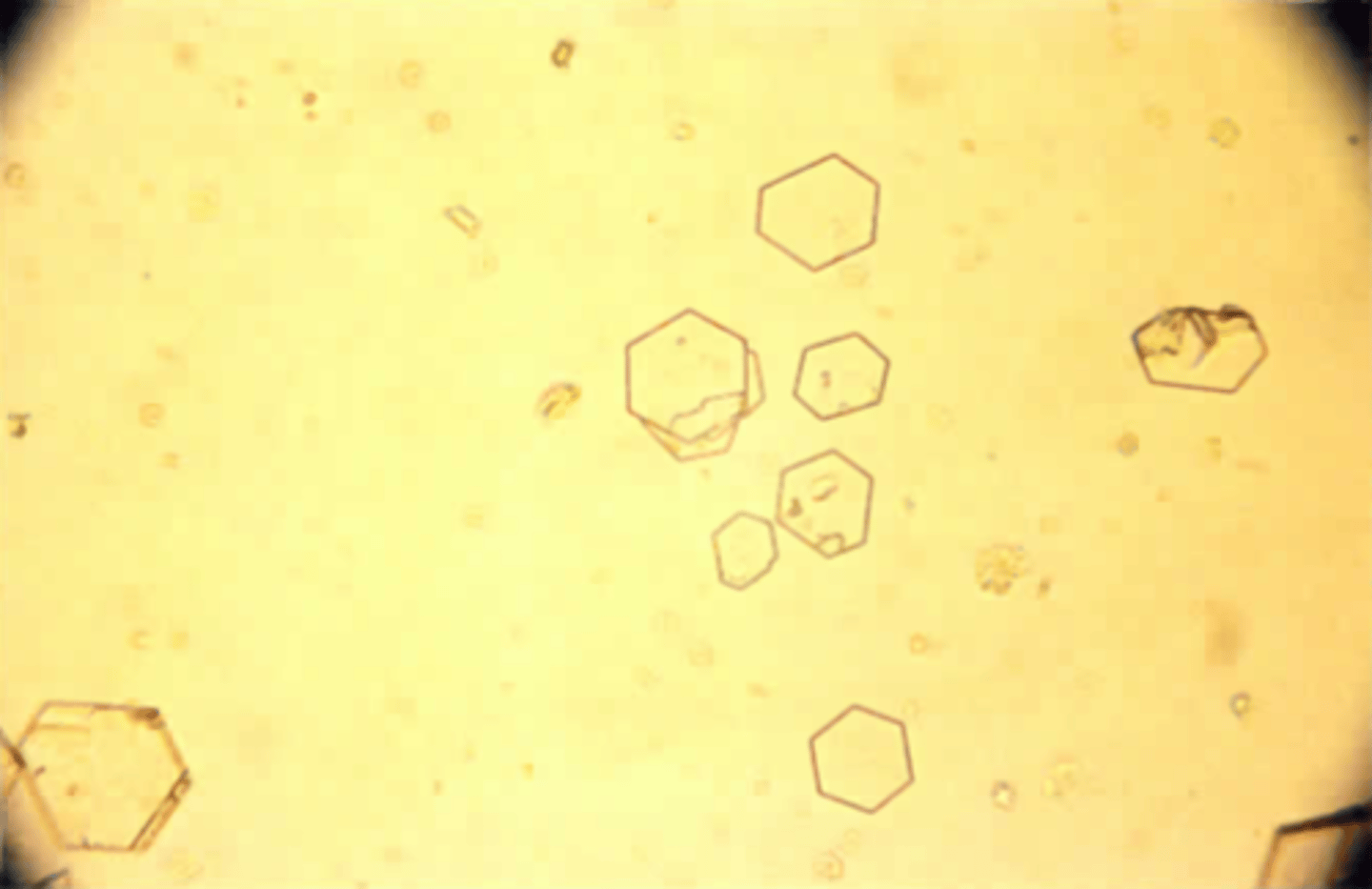
The formed element shown in Color Plate 49 would usually be found in the patient's urine along with which soluble biochemicals?
A. Phenylalanine and tyrosine
B. Ornithine and arginine
C. Isoleucine and leucine
D. Acetoacetic acid and (3-hydroxybutyric
acid
B. Ornithine and arginine
The presence of cystine crystals in a patient sample is always a cause for immediate notification of the physician. Cystinuria is an autosomal recessive disorder characterized by the inability to reabsorb the amino acids cystine, lysine, arginine, and ornithine in either the renal tubules or the intestine. Cystine will crystallize in acid pH more readily than the other amino acids. Tyrosine forms needle-shaped crystals whereas leucine will appear round and oily with concentric rings. Isoleucine and phenylalanine will not form crystals in the urine. Acetoacetate and B- hydroxybutyric acid are two ketone bodies that will be soluble in the sample and give a positive reaction with nitroprusside.
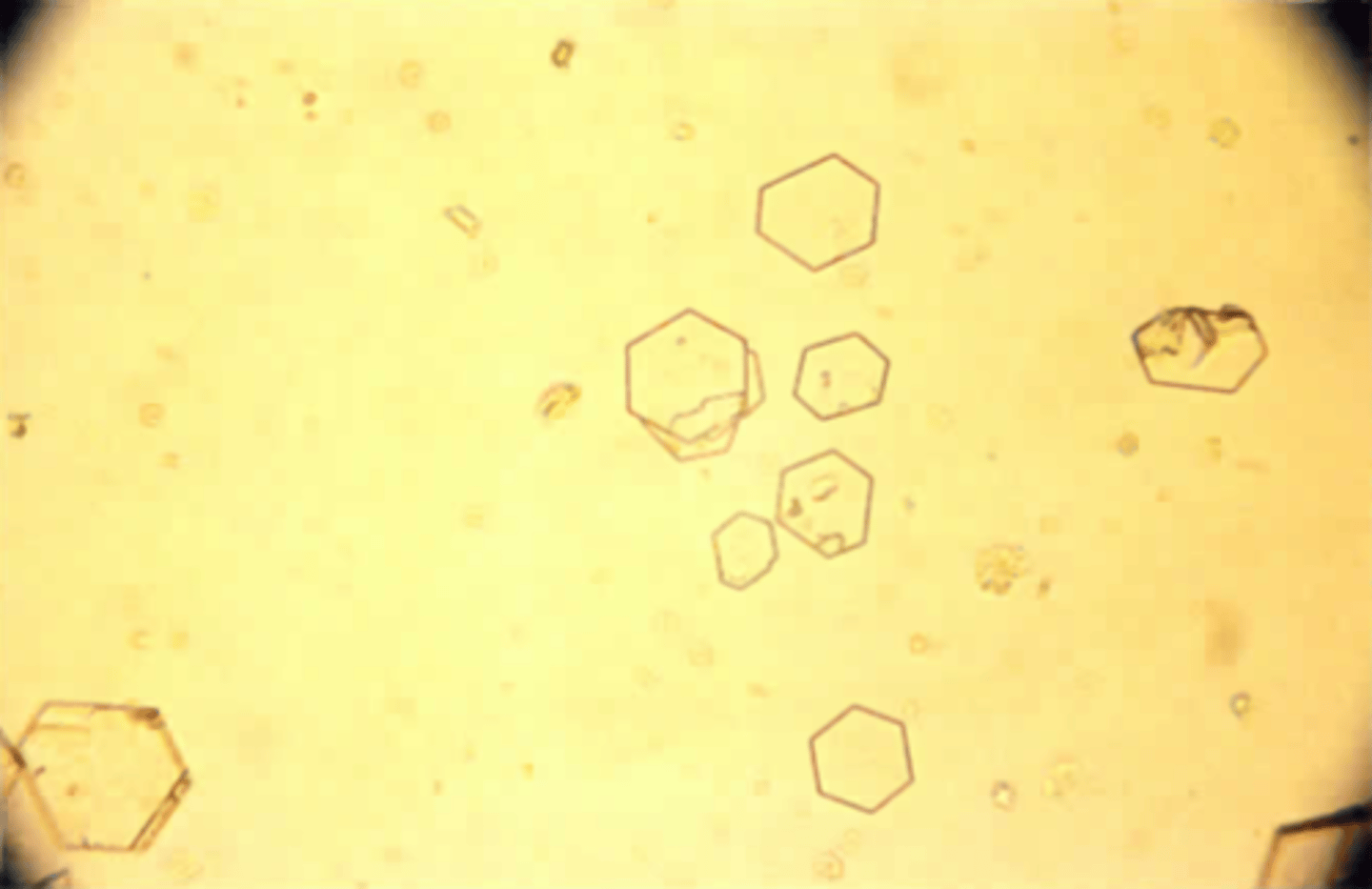
A 13-year-old ice skater is having her routine physical before the school year. Her first morning urinalysis results include color = straw; appearance = hazy; pH = 6.0; protein = trace; a representative microscopic high-power field is shown in Color Plate 50. All other chemical results were normal. The major formed elements are and suggest:
A. Hyaline casts and waxy casts;
nephrotic syndrome
B. Mucus and fibers; no pathology
C. Granular casts and red blood cells;
glomerulonephritis
D. Hyaline casts and mucus; normal
sediment
D. Hyaline casts and mucus; normal
sediment
The major formed elements in Color Plate 50B are hyaline casts and mucus fibers, which are normal in the numbers shown in this field. Waxy casts will appear yellowish with characteristic serrated edges. There are no obvious granules in the casts shown, and red blood cells are not present.
Phenylketonuria may be characterized by which of the following statements?
A. It may cause brain damage if
untreated.
B. It is caused by the absence of the
enzyme, phenylalanine oxidase.
C. Phenylpyruvic acid excess appears
in the blood.
D. Excess tyrosine accumulates in the
blood.
A. It may cause brain damage if
untreated.
The basis for the disease lies in the fact that the enzyme phenylalanine hydroxylase, which is needed for the conversion of phenylalanine to tyrosine, is absent. Because of this enzyme deficiency,
phenylalanine levels rise in the blood, with
increased amounts of phenylpyruvic acid and
other derivatives being excreted in the urine. If the disease is detected at an early stage, mental retardation may be avoided by restricting the dietary intake of phenylalanine.
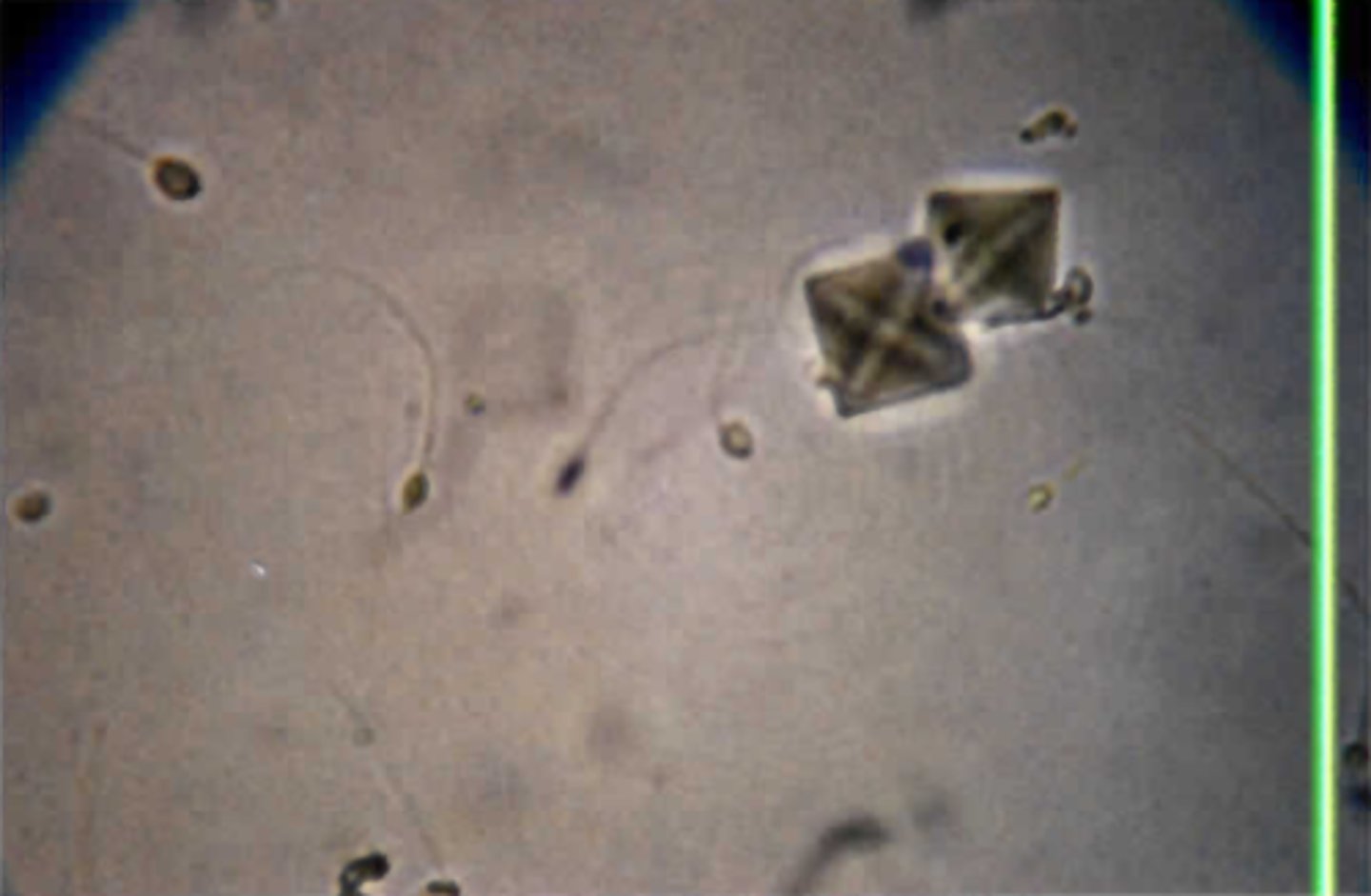
What condition is suggested by the number of the formed element that predominates in the high-power field of Color Plate 51?
A. Glomerulonephritis
B. Improperly collected specimen
C. Pyelonephritis
D. Normal sample
D. Normal sample
Color Plate 51 demonstrates sperm and calcium oxalate crystals. Both formed elements are found in correctly collected normal urines from either gender. Calcium oxalate seen here is the dehydrate form. The monohydrate form will appear oval or dumbbell shaped. Neither formed element is usually associated with pathology.
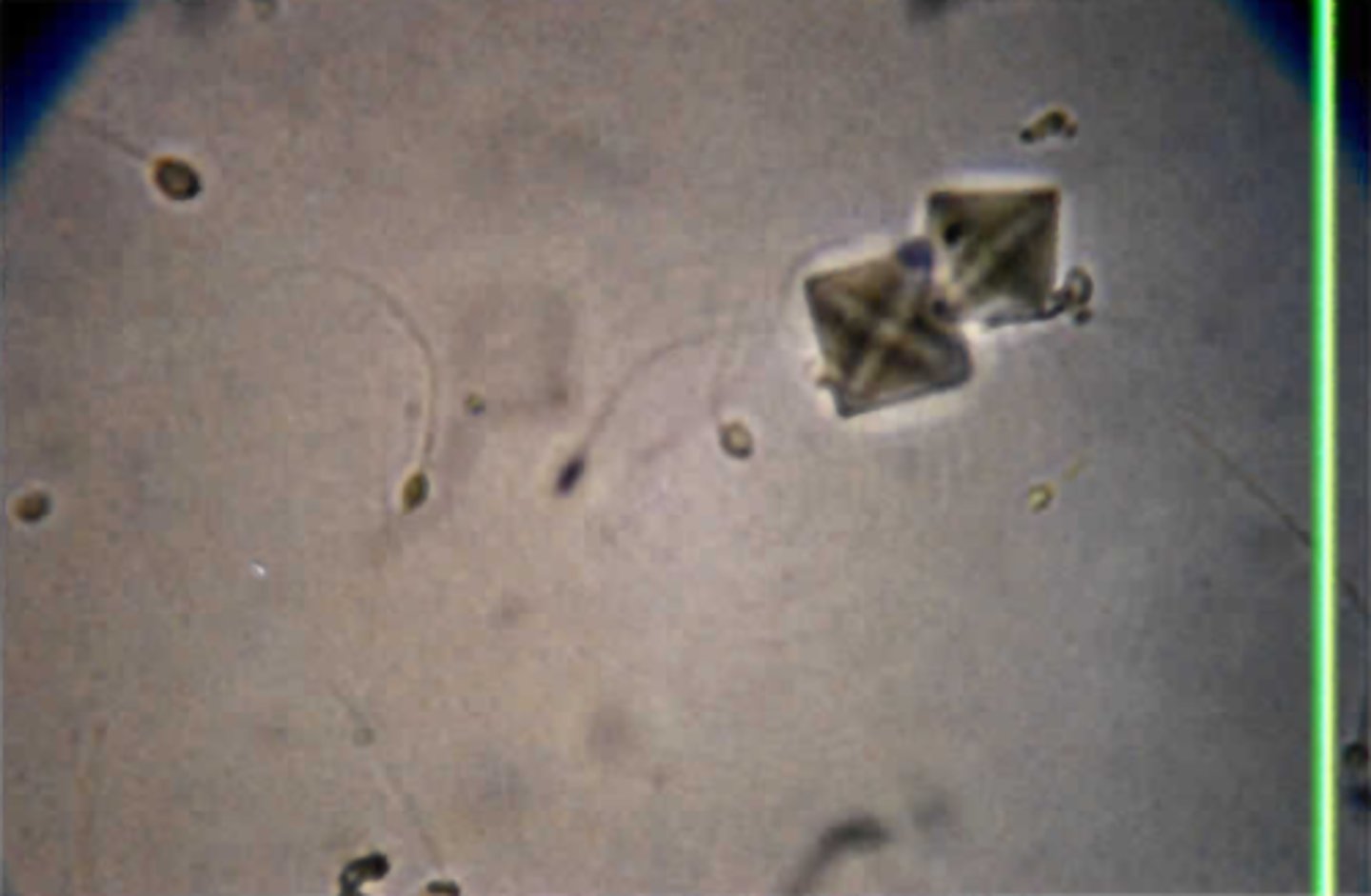
Xanthochromia of cerebrospinal fluid (CSF) samples may be due to increased levels of which of the following?
A. Chloride
B. Protein
C. Glucose
D. Magnesium
B. Protein
A variety of substances in CSF specimens have been associated with a xanthochromic appearance. Among those substances are oxyhemoglobin, carotenoids, bilirubin, and protein. The appearance of the specimen by itself is not usually specific for a particular disease state, but it may provide useful information in comparison with other findings. Glucose, magnesium, and chloride do not contribute to the color of the specimen.
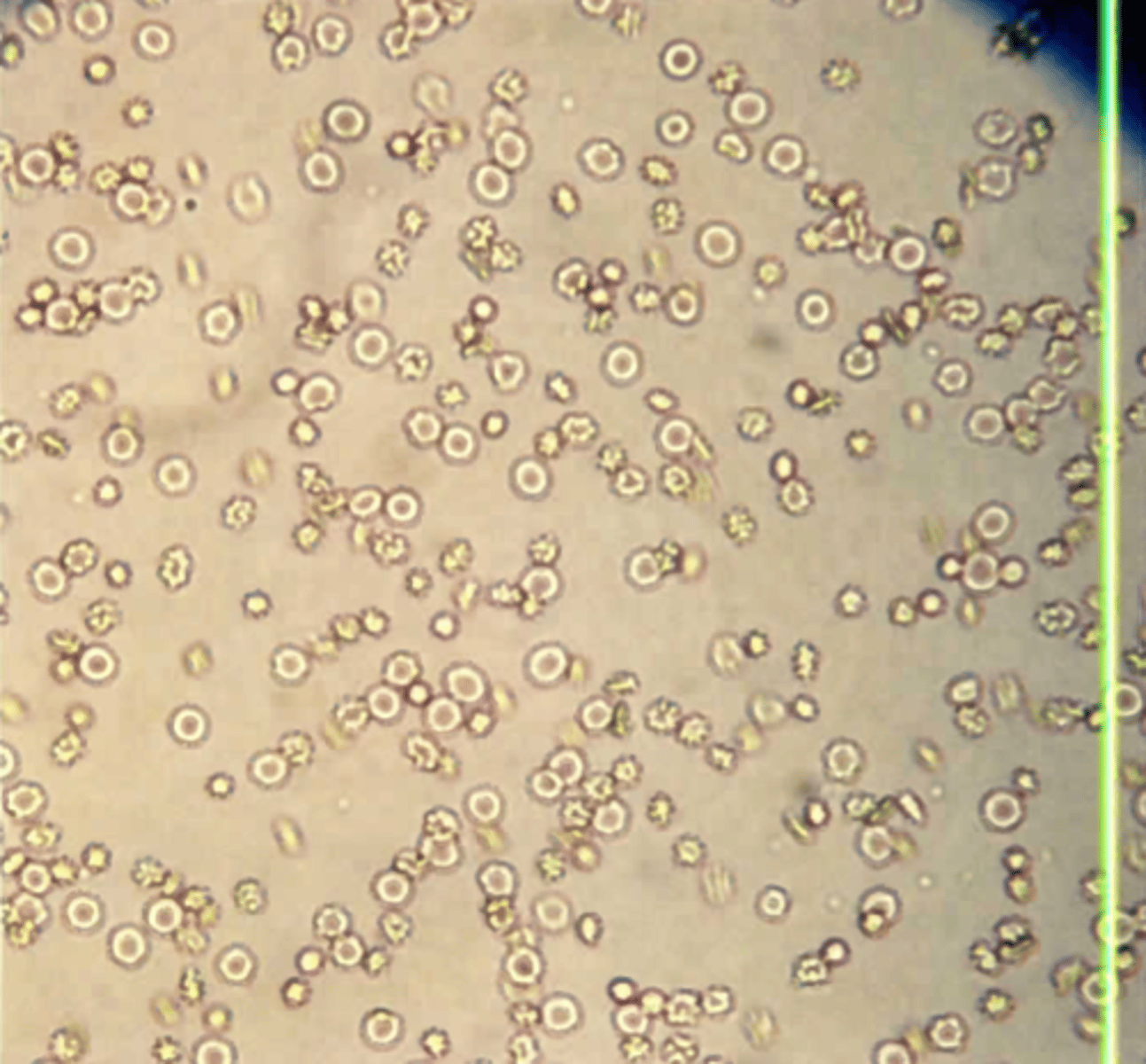
Which of the following will be characterized by an increased number of the urinary component seen in Color Plate 52?
A. Acute glomerulonephritis
B. Biliary tract obstruction
C. Contamination from vaginal discharge
D. Nephrotic syndrome
A. Acute glomerulonephritis
Refer to Color Plate 52. Erythrocytes or red blood cells (RBCs) occur in small numbers (0-2/hpf) in a normal urine. Using brightfield microscopy, unstained RBCs appear as colorless discs with an average size of 7 um in diameter. Increased or large numbers of RBCs are commonly seen with acute glomerulonephritis, renal calculi, acute infections, and menstrual contamination.
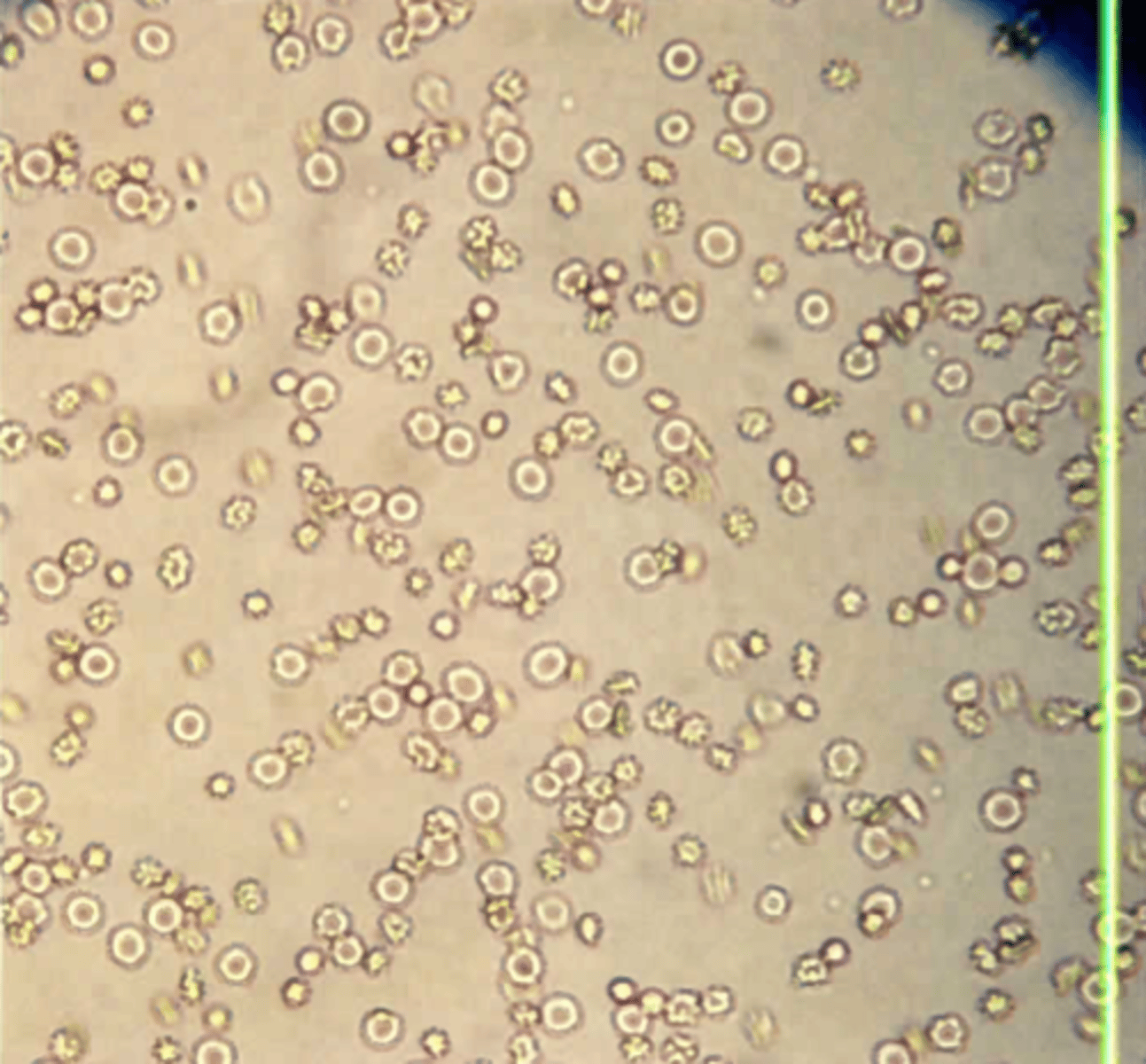
To determine amniotic fluid contamination with maternal urine, which of the following measurements could be used?
A. Creatinine concentration
B. Delta absorbance at 410 nm
C. Albumin/globulin ratio
D. Lactate dehydrogenase
A. Creatinine concentration
Because there may be technical problems associated with amniocentesis, contamination with maternal urine should be considered in evaluating specimens submitted for amniotic fluid analysis. Urinary concentrations of creatinine and urea nitrogen are anywhere from 10 to 50 times the amniotic fluid concentrations, and an increased concentration of either in the amniotic fluid would be sensitive indicators of urinary contamination. Measurements of albumin, total protein, or lactate dehydrogenase would be of little use for this purpose because their relative concentrations in urine and amniotic fluid are not predictably different. A delta absorbance at 410 nm would be used to assess the presence of bilirubin in the sample, as in assessment of erythroblastosis fetalis.
With the development of fetal lung maturity, which of the following phospholipid concentrations in amniotic fluid significantly and consistently increases?
A. Sphingomyelin
B. Phosphatidyl ethanolamine
C. Phosphatidyl inositol
D. Phosphatidyl choline
D. Phosphatidyl choline
The alveolar concentrations of the various
phospholipids (surfactants) change during fetal lung development, and because these changes are reflected directly in the amniotic fluid, a number of investigations have shown that analysis of the fluid can provide good predictive information for the development of respiratory distress syndrome in the newborn. The concentrations of sphingomyelin and phosphatidyl inositol increase until about 32-34 weeks of gestation and then decline. Conversely, lecithin (phosphatidyl choline) and phosphatidyl glycerol concentrations increase rapidly after 32-34 weeks of gestation, and their concentrations relative to
those of the other phospholipids are useful in
assessing the development of fetal lung maturity.
A patient has been diagnosed with an upper gastrointestinal bleed. Which of the following would be characteristic for this condition?
A. Brown stool with streaks of bright red
B. Stool with lack of brown color
("clay-colored")
C. Stool with a much darker brown/black
color
D. Yellow stool with increased mucus
C. Stool with a much darker brown/black
color
The hemoglobin released from red blood cells in an upper gastrointestinal bleed will have time to become denatured and oxidized as it travels the entire intestinal tract. This will make the stool become much darker in color by the time the hemoglobin is excreted. Clay-colored stools will result from an obstruction of the biliary duct, preventing bilirubin from entering the intestines to be converted into urobilinogen and then into urobilin. Stools with red streaks are more likely to result from a lower gastrointestinal bleed, as from the colon. Increased mucus will be associated with intestinal inflammation.
A pleural effusion is found to have 3000 white blood cells per microliter and 5 g/dL total protein. From this it can be determined that the patient's effusion is
A. A transudate
B. An exudate
C. Noninflammatory
D. Hemorrhagic
B. An exudate
Effusions can be transudates or exudates, and the distinguishing characteristics are cell number and total protein. Transudates, being noninflammatory, will have low numbers of cells and less than 3 g/dL protein. This patient's results suggest she has an exudate due to the high number of cells and large amount of protein.
Patients with diabetes insipidus tend to produce urine in________ volume with _________ specific gravity.
A. Increased; decreased
B. Increased; increased
C. Decreased; decreased
D. Decreased; increased
A. Increased; decreased
Diabetes insipidus is caused by a deficiency in antidiuretic hormone. Such deficiencies will result in the kidney's inability to reabsorb water at the distal and collecting tubules. This affects only water reabsorption and not the reabsorption of other urinary solutes. Excreted solute amounts will be the same, but the water volume into which they are excreted will be larger. This results in high urine volumes and low final solute concentrations. The low solute will lead to low specific gravities in these patients' specimens.
The estimation of hyaluronic acid concentration by measurement of viscosity is useful in evaluating which type of fluid?
A. Spinal
B. Peritoneal
C. Pleural
D. Synovial
D. Synovial
Synovial fluid is a form of plasma ultrafiltrate with added hyaluronic acid. Decreased viscosity and poor mucin clot formation are indications of the decreased hyaluronate concentration of synovial fluid. Either of these findings is usually an indication of inflammation. Because the viscosity of synovial fluid is normally very high, it can be estimated by the length of string formed when the fluid drops from a syringe. The term "mucin" in the mucin clot test is a misnomer, because mucin is not present in synovial fluid.
Which of the following is characteristic of an exudate effusion?
A. Leukocyte count >1000/uL
B. Clear appearance
C. Protein concentration <3.0 g/dL
D. Absence of fibrinogen
A. Leukocyte count >1000/uL
Effusions result from an imbalance of the flow of body fluids. Effusions are classified as exudates or transudates on the basis of certain characteristics. Exudates are generally formed in response to inflammation or infection with concomitant capillary wall damage. Exudates are characterized by protein levels greater than 3.0 g/dL, leukocyte counts greater than 1000/uL, and the presence of a sufficient amount of fibrinogen
to cause clotting. In contrast, transudates
are characterized by protein levels less than
3.0 g/dL, leukocyte counts less than 300/uL, and the absence of fibrinogen. Transudates are generally formed as the result of noninflammatory processes, including alterations in plasma oncotic pressure, pleural capillary hydrostatic pressure, or intrapleural pressure.
Which of the following systems utilizes polyelectrolytes to determine the specific gravity of urine?
A. Refractometer
B. Osmometer
C. TS meter
D. Reagent strip
D. Reagent strip
The specific gravity is a measure of the proportion of dissolved solids in a given volume of solvent. Polyelectrolytes are incorporated into urinalysis reagent strips. A dye also present in the strips will change color because of a pKa change in the poly electrolytes. The pKa varies with the ionic concentration of the urine. The color obtained is compared with a set of standard colors, each color correlating with a different specific gravity concentration.
Which methods may be used to quantify protein in both cerebrospinal fluid and urine specimens?
A. Trichloroacetic acid and bromcresol
green
B. Ponceau S and Coomassie brilliant
blue
C. Bromcresol green and Coomassie
brilliant blue
D. Coomassie brilliant blue and
trichloroacetic acid
D. Coomassie brilliant blue and
trichloroacetic acid
Trichloroacetic acid is a turbidimetric method
used to quantify small amounts of protein, less than 100 mg/dL, in cerebrospinal fluid (CSF) and urine specimens. Coomassie brilliant blue is a colorimetric dye binding method in which protein complexes with the dye, forming a soluble blue complex. This method also exhibits the necessary
sensitivity for detecting small quantities of protein.
Which of the following characteristics is true of the primary urinary components shown in Color Plate 53?
A. Consist of uromodulin protein
B. Presence always indicates a disease
process
C. Can be observed with polarized
microscopy
D. Appear yellowish in brightfield
microscopy
A. Consist of uromodulin protein
As seen in Color Plate 53, hyaline casts are the most commonly observed cast, and they consist completely of uromodulin (Tamm-Horsfall) protein. A reference urine may contain 0-2 hyaline casts per low-power field.
A characteristic of substances normally found dissolved in the urine is that they are all
A. Water soluble
B. Inorganic
C. Organic
D. Waste products
A. Water soluble
To be found in urine, a solute must be water soluble. Solutes can be inorganic (e.g., sodium) or organic (e.g., urea). Excreted waste products, meaning end products of metabolism, are creatinine, urea, and uric acid. Some excreted solutes, however, are not present as waste but as overload, such as glucose or sodium.
Which of the following statements applies to the proper collection and handling of CSF?
A. The second tube collected should be
used for chemistry analyses.
B. The third tube collected should be
used for bacteriologic studies.
C. CSF collected in the evening should
be refrigerated and assays performed
only by day-shift personnel.
D. With low-volume specimens, a culture
is performed first, before cell counts
are done.
D. With low-volume specimens, a culture
is performed first, before cell counts
are done.
Low-volume specimens need to be cultured first (to ensure sterility) before any other test is performed. Because the analysis of CSF should be performed immediately, it is critical that personnel on all shifts be able to perform the necessary testing.
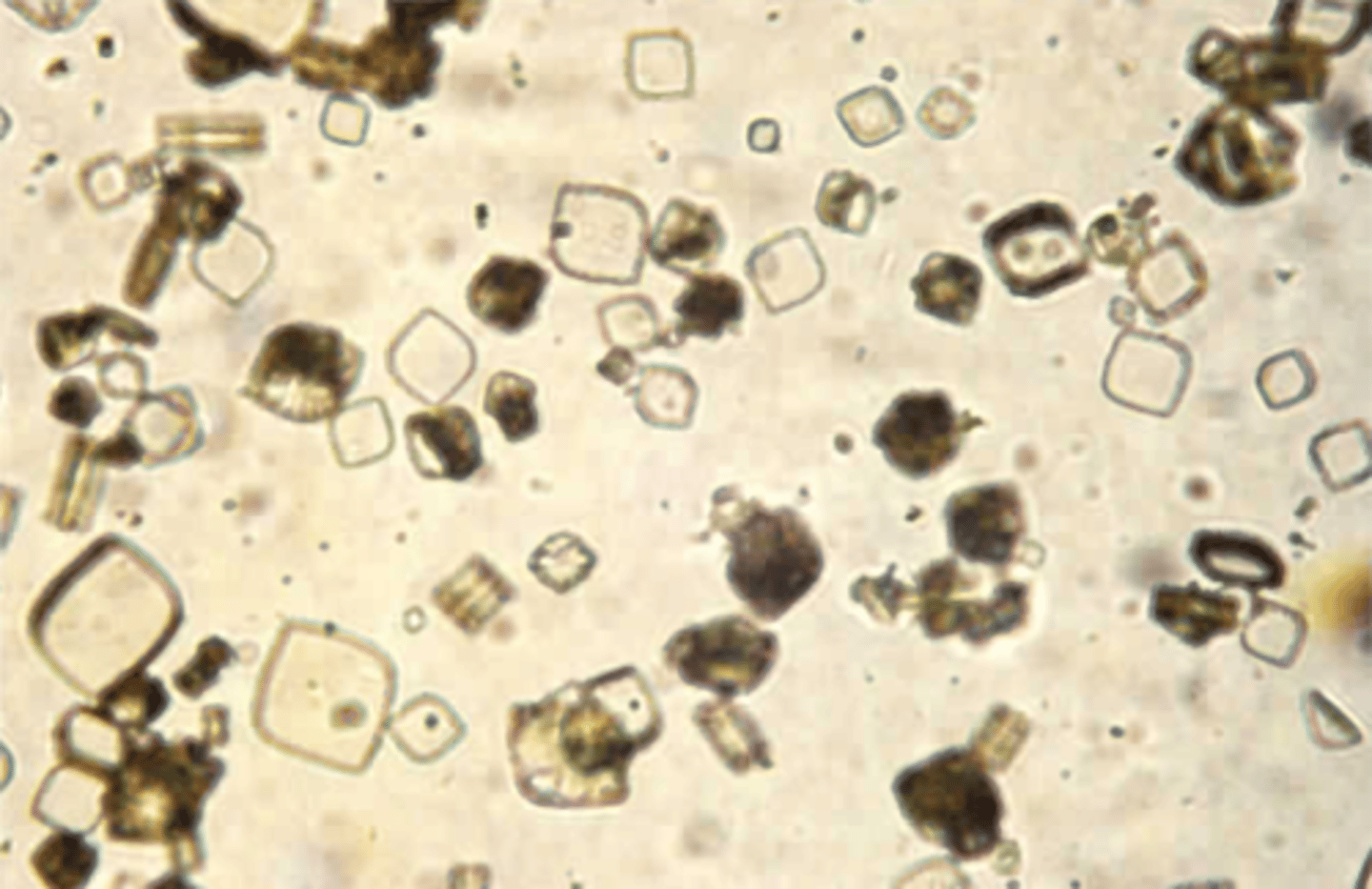
Which of the following characteristics is true for the urinary components shown in Color Plate 54?
A. Never should appear in a freshly
collected sample
B. Can also resemble cysteine crystals
C. Appear insoluble in alkaline urine
D. Presence indicates an inborn error of
metabolism
B. Can also resemble cysteine crystals
Uric acid crystals, as seen in Color Plate 54,
are commonly encountered in normal acidic urine but may be observed in neutral urine and rarely in an alkaline urine, because uric acid is soluble at alkaline pH. Using brightfield microscopy, uric acid crystals appear as diamonds, cubes, barrels, rosettes, and may even have six sides and be confused
with cysteine.
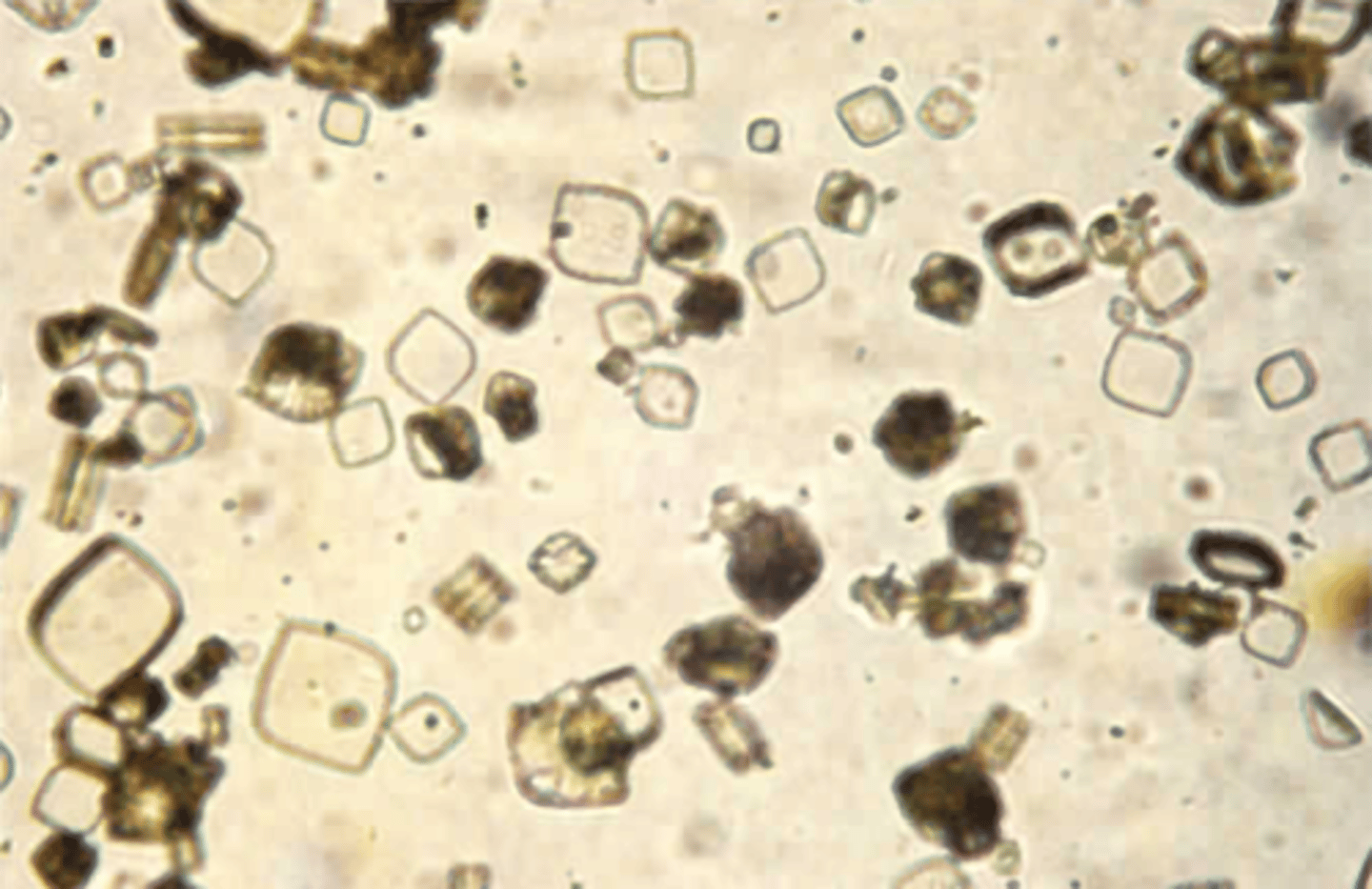
A patient sends the following question to
an online consumer health Web site: "I am
a 22-year-old female who experienced
increasing headaches, thirst, and decreasing
energy. I was studying in the library
when I felt lightheaded and passed out.
I was taken to a hospital emergency
department and they told me that my
serum Acetest® was 40 mg/dL and urine
glucose was 500 mg/dL. What does this
mean?" How would you reply?
A. Your lab results pattern suggests
diabetes mellitus.
B. You probably have been crash dieting
recently.
C. The two results do not fit any disease
pattern.
D. The tests need to be repeated because
they could not possibly occur together.
A. Your lab results pattern suggests
diabetes mellitus.
A positive urine glucose plus a positive serum ketone strongly suggest uncontrolled diabetes mellitus. There is an increased rate of fatty acid oxidation occurring in light of the inaccessibility of the glucose, especially to skeletal muscle. If the patient had only been dieting, the glucose would be negative.
Which urinalysis reagent strip test will never be reported out as "negative"?
A. Protein
B. Urobilinogen
C. Bilirubin
D. Nitrite
B. Urobilinogen
The sensitivity of a method is the lowest concentration of the analyte that will result in a detectable reaction signal. Urobilinogen's
readout color scale begins with its lowest reportable value, but there is no pad associated with concentrations less than this.
The following urinalysis results were obtained on a 40-year-old white male whose skin appeared yellowish during the clinical examination. Color and clarity— dark brown, clear; protein—negative;
glucose—negative; blood—negative; ketones—negative; bilirubin— moderate; urobilinogen—0.2 mg/dL. These results are clinically significant in which of the following conditions?
A. Bile duct obstruction
B. Cirrhosis
C. Hepatitis
D. Hemolytic anemia
A. Bile duct obstruction
Bile duct obstruction is characterized by an obstruction of the flow of conjugated bilirubin into the intestinal tract to complete its metabolism. The conjugated bilirubin, which is water soluble, will be excreted by the kidney. Because bilirubin is not entering the intestines, the normal production of urobilinogen is decreased. Therefore, the urine biochemical test will indicate a positive reagent strip test for bilirubin, positive Ictotest, and "normal" (0.2 mg/dL) urobilinogen (because there is no "negative" urobilinogen).
Compared to the fecal occult blood test, which of the following is a disadvantage of performing a DNA-based test to detect colon cancer?
A. The DNA test is more invasive.
B. The DNA test is less sensitive.
C. The DNA test is more expensive.
D. Additional diet restrictions are needed
for the DNA test.
C. The DNA test is more expensive.
DNA-based tests for detecting mutations within colon cells are generally more expensive than the fecal occult blood (FOB) methods using the pseudoperoxidase property of hemoglobin. Advantages, however, include no diet or medication restrictions prior to the testing, use of a single stool sample, and a sensitivity (50-73%) that far exceeds that of the FOB test (13-35%) for detecting colon cancer. It is, however, less sensitive than colonoscopy, which can detect 95% of colon cancers. Gene mutations associated with colorectal cancer include APC (adenomatous polyposis coli) on chromosome 5; K-ras, a mutation that often occurs after APC mutation; and p53, with mutations occurring later in the process, associated with larger adenomas.
Which of the following may be associated with morphologic examination of spermatozoa?
A. Evaluation should include assessment
of 1000 spermatozoa.
B. A small number of sperm should have
normal morphologic characteristics.
C. Papanicolaou stain may be used.
D. Presence of red or white cells and
epithelial cells need not be noted.
C. Papanicolaou stain may be used.
The morphologic characteristics of spermatozoa are best evaluated by means of smears stained with Papanicolaou stain. Other stains used include Kemechtrot, Giemsa, basic fuchsin, crystal violet, and hematoxylin. When oil immersion is used, a minimum of 200 spermatozoa should be evaluated for morphologic characteristics.
Which condition is characterized by increased levels of immunoglobulins in the cerebrospinal fluid, originating from within the central nervous system and not from the general blood circulation?
A. Gout
B. Erythroblastosis fetalis
C. Multiple myeloma
D. Multiple sclerosis
D. Multiple sclerosis
Immunoglobulins (IgGs) are normally present at less than 1 mg/dL in the CSF. Increased CSF IgG can result from increased CSF production (e.g., multiple sclerosis) or from increased transport from the blood plasma (compromised blood-brain barrier). Neither gout, erythoblastosis fetalis, nor multiple myeloma produces increased CSF IgG levels.
Which of the following statements pertains to screening methods used to determine pregnancy?
A. Immunoassays will use reagent
anti-hCG to react with patient hCG.
B. A random urine specimen is the
preferred specimen for pregnancy
screening tests.
C. Internal controls provided within the
kit will assess if the patient's specimen
was collected correctly.
D. External quality control is not needed
with these methods.
A. Immunoassays will use reagent
anti-hCG to react with patient hCG.
Many simplified yet immunologically sophisticated methods exist currently for determining pregnancy. All are based on the reaction between patient human chorionic gonadotropin (hCG) and anti-hCG. Most kits will use an antibody recognizing one subunit of hCG (alpha or beta), whereas other kits may use both anti-a-hCG and anti-p-hCG.
The following urinalysis biochemical results were obtained from a 4-month-old infant who experienced vomiting and diarrhea after milk ingestion and failed to gain weight: pH—6; protein—negative; glucose—negative; ketone—negative;
bilirubin—negative; Clinitest®—2+. These results are clinically significant in which of the following disorders?
A. Diabetes mellitus
B. Ketosis
C. Starvation
D. Galactosemia
D. Galactosemia
Galactosemia, an inborn error of metabolism, is characterized by the inability to metabolize galactose, a monosaccharide that is contained in milk as a constituent of the disaccharide lactose. Thus galactose appears in elevated levels in the blood and urine. The condition may result in liver disease, mental retardation, and cataract formation if not treated or controlled. In the biochemical analysis of the urine, the conflicting results for
the two glucose tests may be explained as follows: The glucose oxidase reagent strip test is specific for glucose; therefore, the glucose will be negative. The Clinitest®, a modification of the Benedict's test procedure, detects most reducing substances. Because galactose is present in the urine and is a reducing substance, the Clinitest® is positive.
Which of the following is a true statement?
A. Renal tubular cells originate from the renal pelvis.
B. Red blood cells in acid urine (pH 4.5) will usually be crenated because of the acidity.
C. Bacteria introduced into a urine specimen at the time of the collection
will have no immediate effect on the level of nitrite in the specimen.
D. Pilocarpine iontophoresis is the method of choice for the collection of
pericardial fluid.
C. Bacteria introduced into a urine
specimen at the time of the collection
will have no immediate effect on the
level of nitrite in the specimen.
The nitrite reaction requires (a) a sufficient dietary source of nitrate, (b) sufficient numbers of bacteria present in the urine, and (c) sufficient incubation time (>4 hours). Bacteria introduced at collection, even in sufficient number, will not have had sufficient incubation time to convert urine nitrate to nitrite.